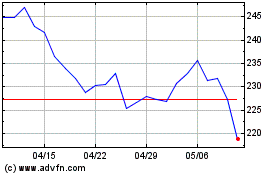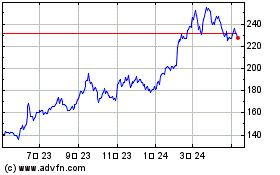Toyota Stays on Course as Rivals Stumble in U.S. -- WSJ
2019年11月8日 - 5:02PM
Dow Jones News
By Sean McLain
This article is being republished as part of our daily
reproduction of WSJ.com articles that also appeared in the U.S.
print edition of The Wall Street Journal (November 8, 2019).
TOKYO -- American car buyers' appetite for pickup trucks and
sport-utility vehicles keeps growing to once-undreamed of levels,
which is generally bad news for Japanese auto makers not named
Toyota Motor Corp.
Toyota, Japan's largest car maker by sales and profit, reported
increased profit in the July-September quarter Thursday and
maintained its guidance for the full year. That bucked a broader
trend among the major Japanese makers that have reported earnings
thus far. All except Toyota lowered their forecasts, at least in
part because of concerns about their prospects in the U.S.
Toyota and other Japanese car makers that used to focus on
sedans spent years playing catchup in the U.S. market, refreshing
old SUV models and ramping up production chasing the SUV-crazy
American car buyer. The problem was all their competitors did the
same thing, and U.S. car makers often did it faster. The wide range
of options means slimmer profits, Japanese car companies say.
Mazda Motor Corp. slashed its sales and profit expectations for
the year ending March 2020 citing the U.S. The Hiroshima-based car
maker overhauled its lineup in an attempt to get shoppers to pay
more, and the new Mazda 3 hatchback and sedan went on sale in March
to rave reviews about their looks and handling.
Nonetheless, U.S. sales of the Mazda 3 were down by more than
20% in the most recent quarter.
The U.S. market "is in a very difficult condition," said Kiyoshi
Fujiwara, Mazda's executive vice president. "There are many
customers who are extremely price-conscious." Mazda hopes a new
small SUV, the CX-30, will help do what the Mazda 3 couldn't.
The better money is in pickup trucks, where a boom in popularity
is leading to record prices. That is buoying the results of General
Motors Co., Ford Motor Co. and Fiat Chrysler Automobiles NV. More
than half of Ford sales in the July-September quarter were pickup
trucks and the figure was about 30% for GM, compared with around
15% at Toyota.
"If you categorize the U.S., it is between trucks and the rest
of the trucks," said Ashwani Gupta, chief operating officer at
Mitsubishi Motors Corp. Mitsubishi revised down its sales
expectations in the U.S. for the rest of the year, despite having
an SUV-heavy lineup, because it didn't think it would make enough
money there.
Toyota is the only Japanese car company with a full lineup of
trucks and SUVs that competes with Detroit across the board, and
that is helping bolster Toyota's healthy business. Revenue in the
July-September quarter rose 4.5% to Yen7.6 trillion ($70 billion)
and net profit rose slightly to Yen592 billion ($5.4 billion),
beating analysts' expectations for a profit fall.
Toyota's problem in the U.S. is getting enough vehicles to feed
the demand. Sales of Toyota's midsize Tacoma truck fell 2.8% in the
U.S. in the July-September quarter, while the overall market for
midsize trucks grew 25%. A Toyota spokesman said a supply shortage
was partly to blame. Executives at the company have said they could
sell around 100,000 more Tacomas a year if they could build them,
and have been scrambling to get a new plant for Tacomas started in
Guanajuato, Mexico.
The heavy competition in SUVs is bad news for Nissan Motor Co.,
which has been looking to dial back spending on financial
incentives. So far, sales volume is down and the profits haven't
picked up. Nissan reports its financial results for the
July-September period on Tuesday.
Write to Sean McLain at sean.mclain@wsj.com
(END) Dow Jones Newswires
November 08, 2019 02:47 ET (07:47 GMT)
Copyright (c) 2019 Dow Jones & Company, Inc.
Toyota Motor (NYSE:TM)
過去 株価チャート
から 3 2024 まで 4 2024

Toyota Motor (NYSE:TM)
過去 株価チャート
から 4 2023 まで 4 2024
